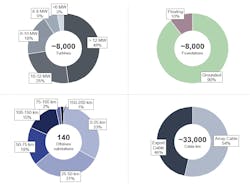Editor's note: This story first appeared in the September-October 2022 issue of Offshore magazine's first annual Offshore Wind Special Report. Click here to view the full Offshore issue or click here to view the special report.
By Alexander Fløtre, Rystad Energy
Russia’s invasion of Ukraine in late February has thrown the spotlight on energy independence in Europe, with several countries setting new and ambitious offshore wind targets for 2030 to replace Russian gas in the power mix. While such targets can help bring certainty to the market, the planned growth would entail a rapid rampup in manufacturing and installation capacities.
In this article, Rystad Energy assesses how much of the planned growth in Western Europe is expected to materialize, what the current outlook would entail for the supply chain and what challenges lie ahead.
Rystad Energy expects operational offshore wind capacity in Europe to grow from 26.1 GW at year-end 2021 to about 135 GW by year-end 2030. The largest capacity additions are expected during the second half of the decade, where new annual capacity is expected to reach more than 25 GW in 2030. While a large portion of the growth during the second half of the 2020s is expected to come from the most established countries in Western Europe, newcomer France will start contributing significant volumes from 2022 onward. Other Western European countries such as Ireland, Sweden, Spain and Portugal are expected to add to this, along with Eastern European countries, primarily in the Baltic and led by Poland. Additional upside could be unlocked if the Netherlands and Germany, among others, were to fully reach their ambitious targets for 2030, following the Esbjerg Declaration in May 2022.
With the strong growth in activity levels, demand for turbines, foundations, transmission infrastructure and capable vessels to install the respective components is expected to grow rapidly. Rystad Energy forecasts a need of about 8,000 turbines and foundations for projects expected to start up between 2023 and 2030, along with about 140 offshore substations and about 33,000 km of inter-array and export cables in the same period.
Adoption of the largest turbines available in the market is expected to be rapid, with almost half of the turbines added between 2023 and 2030 forecast to be larger than 12 MW, and almost three-quarters above 10 MW. While floating wind has gained much momentum in recent years, limited capacity is expected to come online before 2030. About 90% of the capacity additions will come from bottom-fixed offshore wind.
As projects become bigger and gradually move farther from shore, the need for offshore electricity transmission infrastructure increases. Among the 140 offshore substations expected to be needed in Western Europe between 2023 and 2030, more than one-third are forecast to be in offshore wind farms more than 50 km from shore. A small share of the offshore wind farms in the period will be located between 100 and 200 km from shore, requiring high-voltage, direct-current solutions to limit power losses along the export route.
With a growing list of developers aiming to commission offshore wind farms this decade, the race is on to secure the necessary supply. Suppliers such as foundation and cable manufacturers and next-generation wind turbine installation vessel operators are reporting full order books through—and often beyond—2025, and developers have started to lock in supply at an increasingly earlier point in time. Rystad Energy expects the growing demand to lead to project delays during the second half of the 2020s, despite a ramping up of the supply chain. This means that the new and ambitious national targets are unlikely to be fully met by 2030.
One key challenge for the supply chain is the combination of rapidly growing demand and continuously growing component sizes. The general component size increase is primarily driven by the race between turbine original equipment manufacturers (OEM), where Vestas, Siemens Gamesa and GE are competing to have the largest and most efficient offshore wind turbine in the market. This carries with it a need for larger foundations, higher-voltage cables and increased crane capacities. As current supply setups need to be altered to accommodate changing demand, every large-scale change leads to a new investment decision for the suppliers. Moreover, the rapid size growth leads to uncertainty around where sizes will be in the medium to long term and for how long their current or planned specifications will be relevant in the market, and this uncertainty prolongs investment decisions and makes them riskier.
Certain voices in the market, also among turbine OEMs, have expressed a need to stop the turbine size race. A temporary pause in size development could provide the necessary certainty for the supply chain to expand capacities to support the ambitious growth plans in Western Europe toward 2030.






